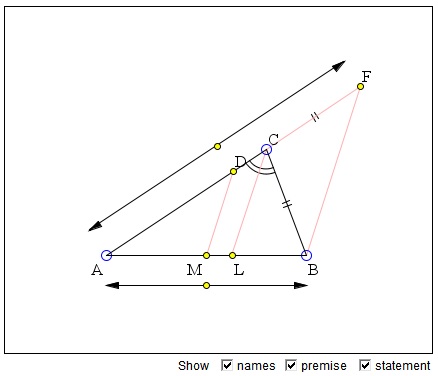The Cleaver: What is this about?
A Mathematical Droodle
| What if applet does not run? |
|Activities| |Contact| |Front page| |Contents| |Geometry|
Copyright © 1996-2018 Alexander BogomolnyThe applet may suggest the following statment:
In ΔABC, let CL be the angle bisector of angle C, M the midpoint of AB, and MD||CL. (D lies on the longest of AC and BC.) Then points M and D split the perimeter of ΔABC into equal halves.

Assume AC > BC. Extend AC beyond C to F such that,
AD = BC + CD.
By construction,
AM + BM,
so that
AM + AD = BM + BC + CD.
The line MD that joins a midpoint of a side with the opposite perimeter-bisecting point is called a cleaver. The three cleavers in a triangle intersect at the Spieker center of the triangle.
References
- R. Honsberger, Episodes in Nineteenth and Twentieth Century Euclidean Geometry, MAA, 1995, pp. 2-4
|Activities| |Contact| |Front page| |Contents| |Geometry|
Copyright © 1996-2018 Alexander Bogomolny73579122
